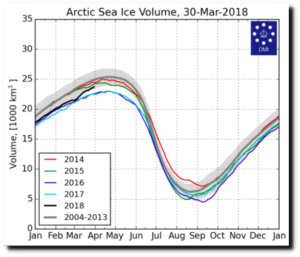By Tony Heller, April 1, 2018 in TheDeplorableClimSciBlog
With temperatures of -30C and Arctic sea ice nearing its winter maximum, government climate scientists and their useful idiots in the press announce that Arctic sea ice is “near an all time low.”
In the actual Arctic, sea ice extent is increasing, more than
double six months ago, and essentially identical to all recent years (…)

by P. Homewood, April 1, 2018 in NotaLotofPeopleKnowThat
Lake Chad – a source of water to millions of people in West Africa – has shrunk by nine-tenths due to climate change, population growth and irrigation. But can a scheme dating back to the 1980s save it?
“It’s a ridiculous plan and it will never happen.” That’s the reaction many people have to the idea of trying to fill up Lake Chad and restore it to its former ocean-like glory by diverting water from the Congo river system 2,400km (1,500 miles) away.
by Eric Worrall, April 1, 2018 in WUWT
Huffington Post has noticed that many university academics are utter climate hypocrites, that many of them rate their personal importance by how many professional air miles they can accumulate every year (…)
See https://www.huffingtonpost.com/entry/opinion-dolsak-prakash-carbon-tax_us_5abe746ae4b055e50acd5c80?ncid=engmodushpmg00000004
by Willy Eschenbach, March 30, 2018 in WUWT
People have asked about the tools that I use to look for any signature of sunspot-related solar variations in climate datasets. They’ve wondered whether these tools are up to the task. What I use are periodograms and Complete Ensemble Empirical Mode Decomposition (CEEMD). Periodograms show how much strength there is at various cycle lengths (periods) in a given signal. CEEMD decomposes a signal into underlying simpler signals.
Now, a lot of folks seem to think that they can determine whether a climate dataset is related to the sunspot cycle simply by looking at a graph. So, here’s a test of that ability. Below is recent sunspot data, along with four datasets A, B, C, and D. The question is, which of the four datasets (if any) is affected by sunspots?
La géologie, une science plus que passionnante … et diverse

